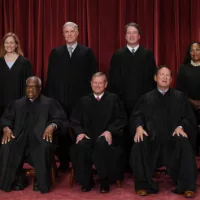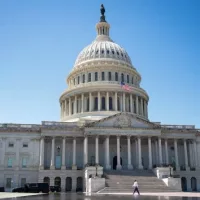
(WASHINGTON) — On the campaign trail, and in the weeks leading up to his return to the White House, President Donald Trump vowed to hit the ground running — what experts describe as a “flood the zone” strategy to push forward on his conservative and controversial policies.
The pace has meant an often unprecedented first 100 days in office: “Trump speed,” the White House calls it.
Earlier this month, he told Republican lawmakers at a party dinner: “We’re setting records right now. We’re getting more things approved than any president has ever done in the first 100 days. It’s not even close. I had somebody say the most successful month — first month in the history. Now they said the most successful 100 days in the history of our country.”
How he’s done so, legal experts told ABC News, will have a long-lasting impact on the presidency and the federal government.
His main strategy has been to sign executive orders almost daily, including ones that challenge Congress’ power to fund and oversee federal agencies and programs, while others relentlessly test the limits of immigration enforcement.
Other presidents on both sides of the aisle have tried to flex their executive muscle, such as President Joe Biden’s EO to require 50% of cars and light trucks sold to be zero-emission electric vehicles by 2030, according to Tabitha Bonilla, research assistant professor at the Institute for Policy Research at Northwestern University.
“Every president over the last few decades have been trying to add more power to the executive branch and forward their agenda,” Bonilla told ABC News. “Trump is taking that to the extreme.”
As an example, experts cited Trump using legal and financial threats to punish universities and law firms for alleged political opposition and failure to “align” with his agenda, as well as his wholesale firings of top career officials, replacing them with loyalists.
James Sample, a constitutional law expert at Hofstra University, said that Trump’s playbook appears to be straight out of Project 2025, a blueprint for “taking the reins of the federal government” prepared for years by Trump’s most conservative allies in anticipation of his comeback — although Trump claimed to never have read it.
Trump and his supporters said his actions are justified because unelected bureaucrats and judges, they claim, had seized control from presidents — the one person elected nationwide, they argue, and granted total executive power by the Constitution.
Regardless, Sample said, the tactic should raise a red flag.
“The purpose of a blitzkrieg is to overwhelm the opposition,” he said.
While Trump’s tactics have been met with little to no protest from the Republican lawmakers who control the House and Senate, the judicial branch has often been ready to stem the flood through rulings and injunctions in dozens of court cases.
Still, experts told ABC News, that even if all of Trump’s moves are blocked or even reversed, they have done both serious short-term and long-term damage.
“It’s all about implanting the narrative,” Bonilla said. “Trump’s policies and rhetoric have pushed everything to the right and hurt our strength on the global scale.”
Floodgates opened
Since Trump took office on Jan. 20, he has issued more than 140 executive orders on various policies as of Monday, shattering records and upending widely held interpretations of federal law and the Constitution.
President Joe Biden, by comparison, issued 162 EOs in his entire term, and Trump issued more than 30 executive orders during the first 100 days of his first term, according to historical records.
White House chief of staff Susie Wiles told Fox News in March that in this second term, the Trump team knew it needed to act fast, citing the midterm elections in November 2026 that could change the congressional map.
“This 18 months is our time frame. One hundred days, certainly six months into the year, and 18 months, are sort of our benchmarks,” she said.
The “flood the zone” goal has been long-touted by Trump’s allies.
His former White House political adviser Steve Bannon appeared to coin the idea during Trump’s first term. After Trump left office, conservative activists and Trump loyalists crafted a proposed battle plan for a second term.
In a 2023 speech, Russell Vought, a chief architect of Project 2025 and now Trump’s current director of the Office of Management and Budget, laid out one strategy at his Center for Renewing America, a pro-Trump Washington think tank.
“I want the bureaucrats to be traumatically affected because they are increasingly viewed as villains. We want to put them in trauma,” he said in a speech reported by ProPublica.
Video of his making that speech was brought up during Vought’s confirmation hearings earlier this year but he repeatedly avoiding answering questions about his provocative rhetoric and plans.
Many of Trump’s EOs have dealt with Elon Musk’s brainchild — the Department of Government Efficiency, which has slashed agency budgets and tens of thousands of federal employees throughout the country, while others have pushed forward the president’s crackdown on immigration, such as the end to birthright citizenship and deporting migrants as alleged foreign invaders under the 1798 Alien Enemies Act.
Bernadette Meyler, the Carl and Sheila Spaeth professor of law at Stanford Law School, told ABC News that executive orders have always been a tool presidents have used to set their agenda, even if just symbolically.
“It is an effective tactic. It’s difficult even for courts to react rapidly,” Meyler said.
Conservative groups have long advocated for a federal government shakeup and agued that the president needed more power to make the country more efficient.
“What he’s doing is kickstarting what will ultimately be our legislative agenda,” House Speaker Mike Johnson said in January after Trump’s first round of executive orders.
The Heritage Foundation, the far right think tank that helped to produce Project 2025, has contended that Trump’s efforts are essential and fast action can make the government more efficient.
Lindsey Burke, director of the Center for Education Policy at The Heritage Foundation, and Jonathan Butcher, a senior research fellow at the think tank, referenced this idea in a statement last month after Trump issued an executive order for a drastic reduction in force for the Department of Education.
“Reducing the bloated bureaucracy will give state and local education officials more decision-making authority,” they said.
War of words, resistance to courts
Legal experts said another effective aspect of the “flood the zone” tactic was Trump’s multiple media appearances and photo ops, where he continues to make controversial and provocative claims.
Meyler contends Trump’s war of words is part of a deeper tactic to undermine the public’s trust in the federal government.
She noted even with courts issuing injunctions, Trump’s statements and resistance to judge’s orders with aggressive appeals has still moved the needle more toward the right.
“It can seem he is doing a lot even without of lot of judicial action,” Meyler said.
How much steam is left?
Trump and his allies have been adamant that they will stick to their plans to reassert the powers of the executive branch long after the first 100 days are up and are vowing to take all of their cases up to the Supreme Court if necessary.
As of Sunday, there have been 217 court cases against the second Trump administration, according to an ABC News accounting, and a large majority of those have led to temporary restraining orders, reversals and, in some cases, full-on blocks of Trump’s agenda.
“In the first Trump administration, we saw a lot of executive actions in the beginning and then saw it slow down,” Bonilla said. “We will be living in the space of a lot happening all at once for a while, but at some point, there is going to be a moment where there is so much that [the executive branch] can’t keep up.”
Meyler agreed but added that Trump, the Project 2025 architects and their allies have stated that they are willing to work with Congress to get their agenda passed through legislative channels.
“That might secure his policies, and slow things down, and avoid the courts,” she said.
That pivot will meet more resistance, especially as we approach the midterms, according to Meyler.
“It’s easier for some than others because of various practical matters, but there is a tipping point,” she said. “People are already protesting and Trump’s public ratings are dipping.”
Still, future presidents will likely emulate the “flood the zone” tactic in their first weeks, according to Meyler.
“Over the long course of presidential history, there is rarely a retraction of presidential power,” she said.
Copyright © 2025, ABC Audio. All rights reserved.














